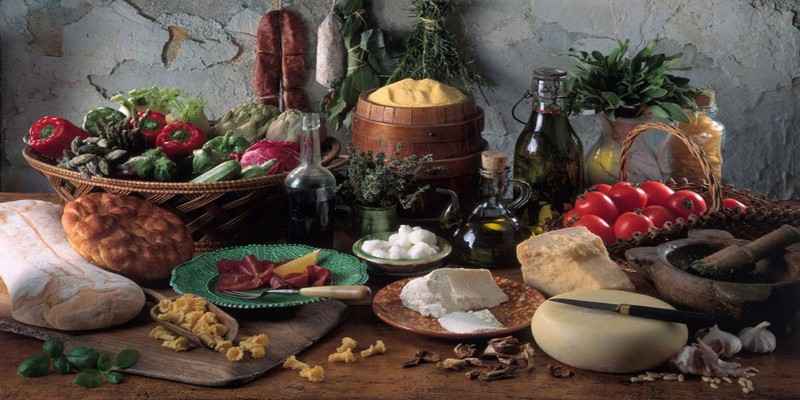Local products

As mentioned by Herodotus, Naxos surpassed all the islands in wealth (he pronounced the bliss of the islands) and many of its products were known in antiquity, such as Naxos marble, emery (naxia stone), wine (there was even a variety of grape " naxia kaloumeni"), almonds, sheep and goats and cypress, an aromatic plant with healing properties.
Cheese making
- Naxos PDO graviera is the most famous cheese of the island and one of the few PDO Greek cheeses made from cow's milk. It is produced mainly from raw milk of local cows that have adapted to the conditions of the island. It may also contain goat and sheep milk, also from Naxos animals, up to 20%. It ripens for 80-90 days. It is produced by the Union of Agricultural Cooperatives of Naxos.
- The so-called male kefalotiri is made from goat's milk mainly from the mountain villages, which is usually collected in the barns or in the matatas, and which, with the addition of rennet, is boiled and gives the so-called "manoura" which is then drained into straw baskets (made from dried burla) the so-called "tsimiskia". After draining, they are then removed from the tsimiskas and placed on boards in a cool and dark place, in the houses or in the matatas. After about six months, during which regular smears are made with pure oil, the male kefalotiri is ready for consumption with a special characteristic taste.
- The so-called oil cheese (Naxos) is the male cheese that is created if, after its preparation, it is placed in a container with olive oil for a period of more than three months. It is a spicy cheese accompanied by certainly local raki.
- The so-called sweet myzithra (Naxos) is also made from goat's milk. Specifically, during the initial boiling of the milk, the "manoura" is removed (from which, as mentioned above, the male cheese is prepared) and the sweet mizithra is now collected from the cauldron, which is also placed in special containers. This is a special unsalted cheese product more for a fat-free diet.
- Just as there is the so-called "male" cheese, the female cheese called anthotiro is also made in Naxos. Anthotiro is transformed myzithra that has been kept for more than a year. It is a product that appears lightly salted and devoid of fat.
- Xinogala or xinogalo is made from unadulterated cold goat's milk with the addition of rennet which is then strained to create xinomyzithra. It is customary to add a small amount of pepper to make it more spicy.
- The so-called sour cheese is the transformation of the sour myzithra after drying it for a few weeks on boards. It is a product that acquires a particularly delightful taste over time.
Other agricultural products
The natural landscape in Naxos has many changes as the big mountains succeed fertile plains and ravines. Naxos has a rich aquifer that plays an important role in the fertility of the land which offers excellent local products such as Naxos PDO potatoes, onions, wine, olives (table known as escudos), oil, raki and the local drink lemon. Citrus fruits and various spoon sweets are also produced (grape, cherry, cherry, orange, bergamot, fig, walnut, etc.). Naxos Lemon Liqueur is a trademark of the city and is sold plain or in two colors, green with chlorophyll and yellow with lemon.
Distillery
At the end of September, the process of distilling the raki, known to the residents of the region as rakijo, begins. The preparation of raki is an important event for the inhabitants of the island's settlements who gather and dance to the sounds of live traditional music. Equally famous is the fragrant liqueur, the Naxos lemon, which is based on the leaves of the lemon tree.
Minerals
In Naxos, between the villages of Koronos and Apeiranthos, there is the area with the fewest emery mines in the world and unique in Greece (commonly known as "emery"), while the marbles and granite that come from the island are still known since ancient times. .
Until 1925, the emery was transported by mules to the nearest port of Moutsouna to the mines (Epiranthos port), from where it was loaded onto the ships that received it, a particularly laborious, time-consuming and expensive method. In 1925, a monumental project for its time was built, the "Aerial Railway", a system of pylons, wire ropes and cable cars, with which the mineral was transported from then on, crossing the mountains from the mines to Moutsuna. Air travel drastically reduced the time and cost of transportation, but it was also abandoned in 1978,[52] when road construction made trucking even more affordable. However, an important part of the aerial is still preserved and the visitor can admire it on the route from Apeiranthos to Moutsouna.
Emery, or “emery” as the locals call it, is a mineral used as an abrasive and abrasive for metals, glass, wood or rocks, but also as an anti-slip material for floors, roads and pavements. Naxian emery has been one of the most important Greek minerals for a long time. Naxos is essentially the only emery-producing region in Europe, since these mines are the largest in the world. The residents of the six villages of Epiranthos, Koronos, Danakos, Keramotis, Skados and Mesis have the exclusive right to mine emery. Men over the age of 18 have the possibility to register in the lists of emery workers and mine the emery but with the obligation to hand it over to the Greek government, which is the sole exploiter.
Emery was known to the ancient Greeks as "lithos o tas votos oi dactilioglifoi smihousi...". From the archives of the Historical and Ethnological Society it is established that from 1625 emery was circulating as a commodity, a fact which is also evidenced by archaeological finds (emery stones) from central Naxos.
Πηγή: https://el.wikipedia.org

